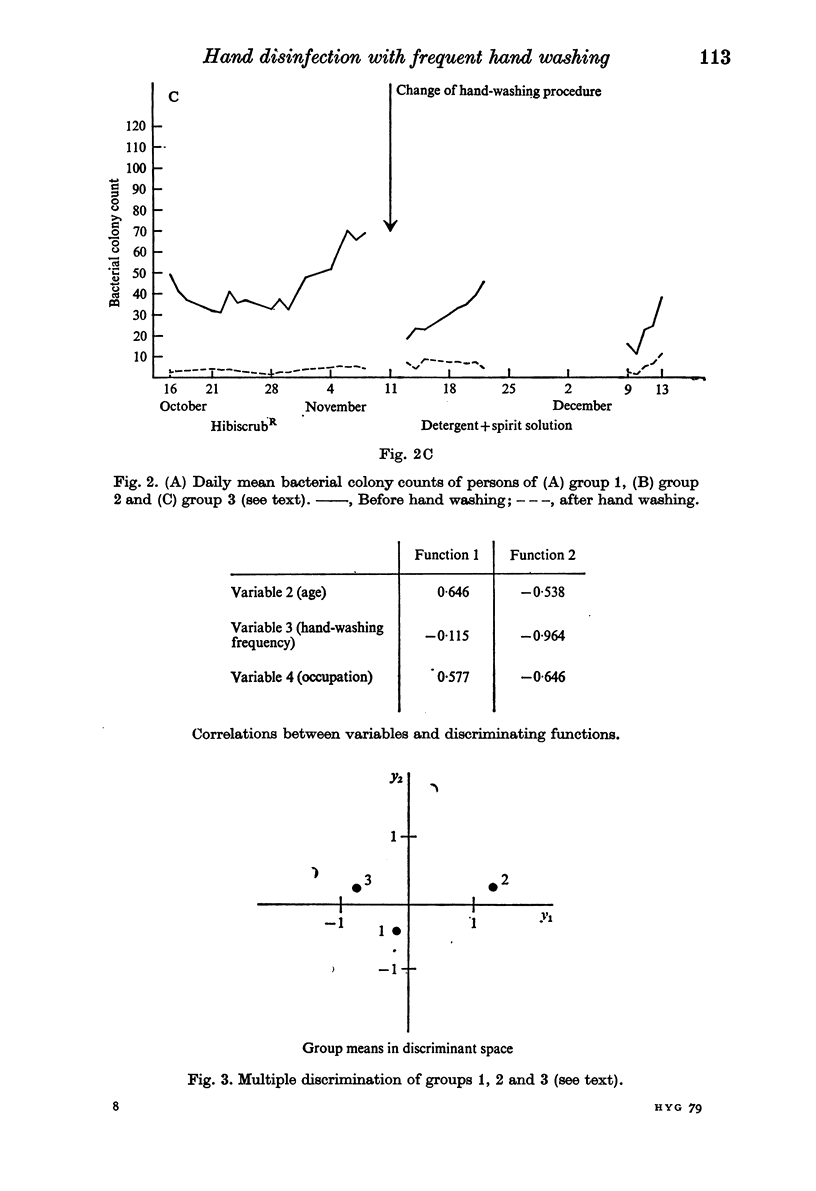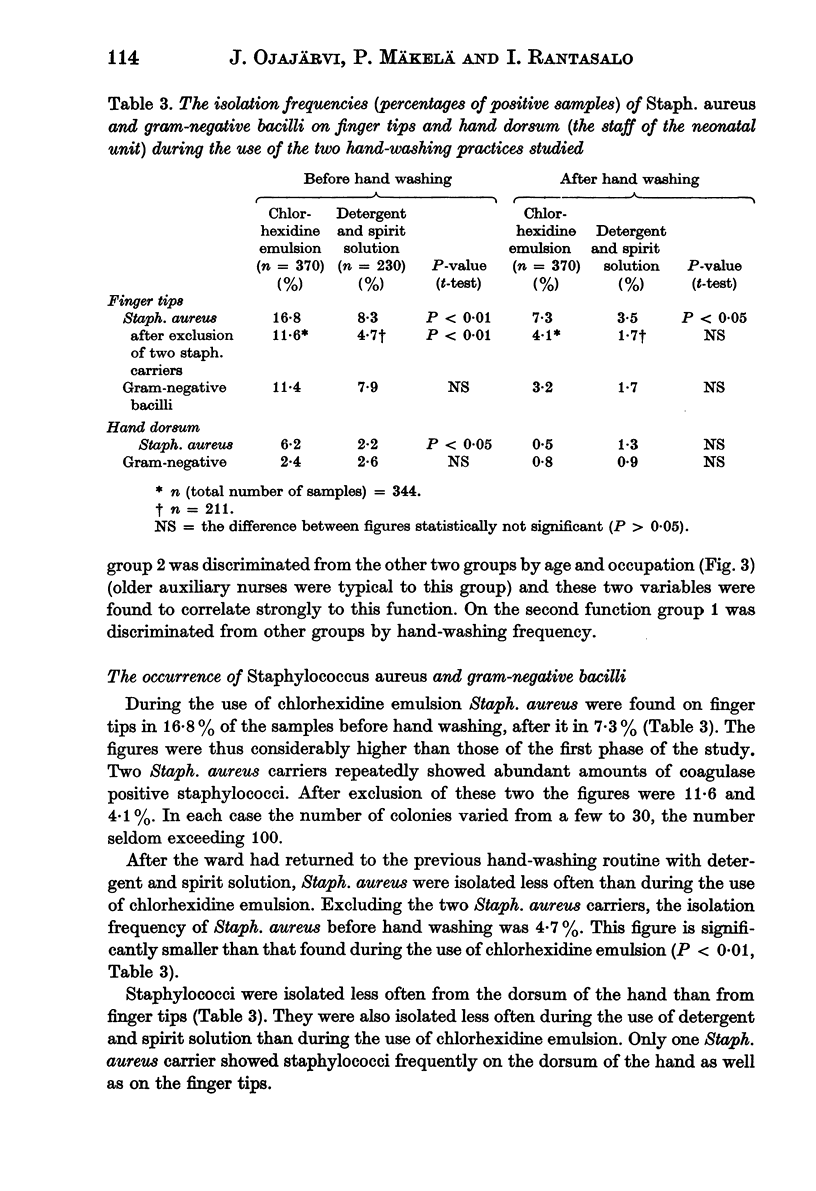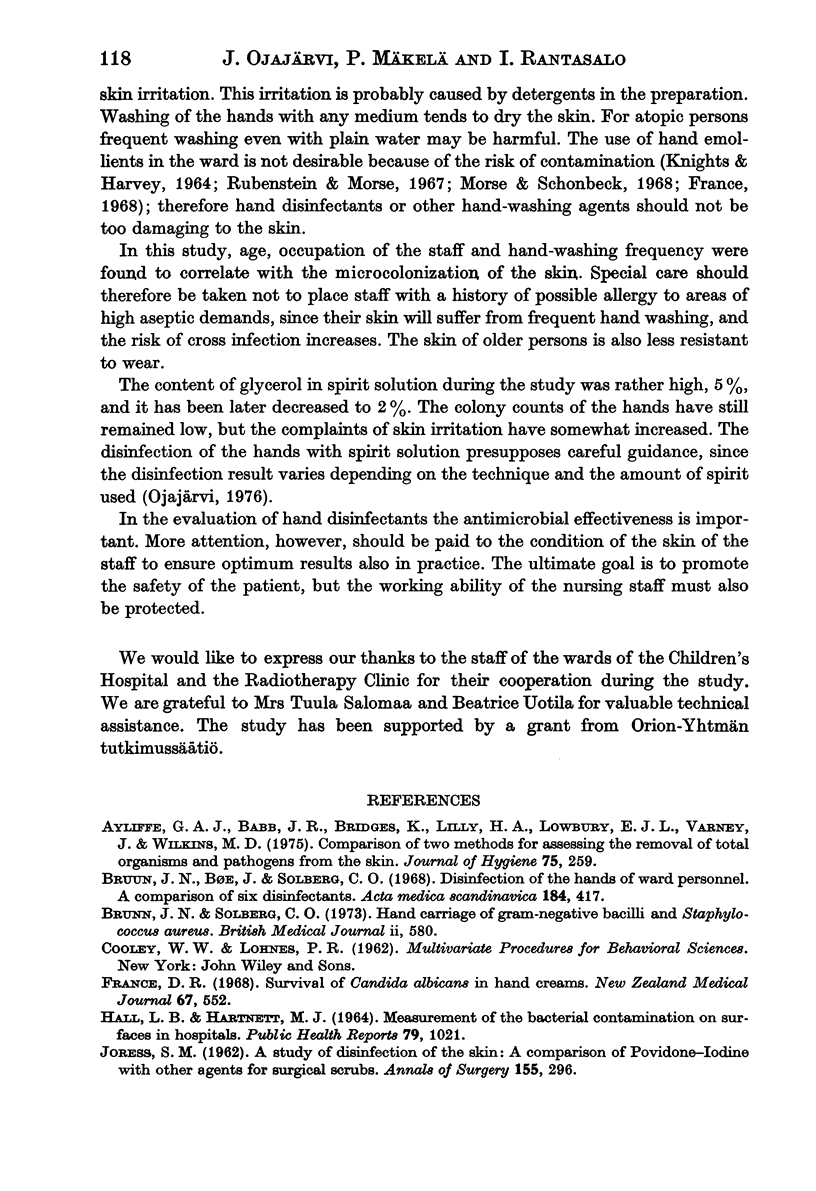Abstract
In a prolonged field trial a 4% chlorhexidine digluconate detergent scrub (HibiscrubR), that had earlier proved to be an effective hand disinfectant, was studied in hospital wards. Finger tips were found to harbour more bacteria than the hand dorsum and the samples collected from them yielded more information on the bacteriological and dermatological effects of hand disinfectants in practice.
In wards with a relatively low hand-washing frequency (less than 20 times in 8 hours) the bacteriological results resembled those obtained by in-use tests with volunteers. In the neonatal unit where the hand washing frequency was remarkably high, even occasionally over 100 times/8 h shift, an increase in the bacterial colony counts of the majority of the staff was recorded both before and after hand washing already after using the preparation for 1 week. Age, occupation and hand-washing frequency all correlated with the bacteriological results. Twenty-seven out of 37 persons complained of side effects such as wounds of finger tips and redness or heavy drying of the skin. Wounds, particularly on finger tips, resulted in the failure of disinfection. An increase in bacterial counts was sometimes noted without any dermatological or subjective changes. Drying of the skin was complained of less often when no increase in skin bacteria occurred.
After the changeover of washing practice to a detergent followed by a rinse with spirit solution containing chlorhexidine and glycerol a decrease was recorded in the bacterial counts. It is concluded that more attention should be paid to long-term testing of hand washing and disinfection methods to ensure optimum final results in practice. It is obvious that the knowledge obtained from short time in-use testing cannot be applied to all conditions of use.
Full text
PDF












Selected References
These references are in PubMed. This may not be the complete list of references from this article.
- Ayliffe G. A., Bridges K., Lilly H. A., Lowbury E. J., Varney J., Wilkins M. D. Comparison of two methods for assessing the removal of total organisms and pathogens from the skin. J Hyg (Lond) 1975 Oct;75(2):259–274. doi: 10.1017/s002217240004729x. [DOI] [PMC free article] [PubMed] [Google Scholar]
- Bruun J. N., Boe J., Solberg C. O. Disinfection of the hands of ward personnel. A comparison of six disinfectants. Acta Med Scand. 1968 Nov;184(5):417–423. doi: 10.1111/j.0954-6820.1968.tb02481.x. [DOI] [PubMed] [Google Scholar]
- Bruun J. N., Solberg C. O. Hand carriage of gram-negative bacilli and Staphylococcus aureus. Br Med J. 1973 Jun 9;2(5866):580–582. doi: 10.1136/bmj.2.5866.580. [DOI] [PMC free article] [PubMed] [Google Scholar]
- France D. R. Survival of Candida albicans in hand creams. N Z Med J. 1968 May;67(432):552–554. [PubMed] [Google Scholar]
- JORESS S. M. A study of disinfection of the skin: a comparison of povidone-iodine with other agents used for surgical scrubs. Ann Surg. 1962 Feb;155:296–304. doi: 10.1097/00000658-196200000-00020. [DOI] [PMC free article] [PubMed] [Google Scholar]
- KNIGHTS H. T., HARVEY J. HAND CREAMS CONTAINING HEXACHLOROPHENE AND CROSS INFECTION WITH GRAM NEGATIVE BACTERIA. N Z Med J. 1964 Oct;63:653–655. [PubMed] [Google Scholar]
- LOWBURY E. J., LILLY H. A., BULL J. P. Disinfection of the skin of operation sites. Br Med J. 1960 Oct 8;2(5205):1039–1044. doi: 10.1136/bmj.2.5205.1039. [DOI] [PMC free article] [PubMed] [Google Scholar]
- Lilly H. A., Lowbury E. J. Disinfection of the skin with detergent preparations of Irgasan DP 300 and other antiseptics. Br Med J. 1974 Nov 16;4(5941):372–374. doi: 10.1136/bmj.4.5941.372. [DOI] [PMC free article] [PubMed] [Google Scholar]
- Morse L. J., Schonbeck L. E. Hand lotions--a potential nosocomial hazad. N Engl J Med. 1968 Feb 15;278(7):376–378. doi: 10.1056/NEJM196802152780706. [DOI] [PubMed] [Google Scholar]
- Morse L. J., Williams H. L., Grenn F. P., Jr, Eldridge E. E., Rotta J. R. Septicemia due to Klebsiella pneumoniae originating from a hand-cream dispenser. N Engl J Med. 1967 Aug 31;277(9):472–473. doi: 10.1056/NEJM196708312770906. [DOI] [PubMed] [Google Scholar]
- Ojajärvi J. An evaluation of antiseptics used for hand disinfection in wards. J Hyg (Lond) 1976 Feb;76(1):75–82. doi: 10.1017/s0022172400054966. [DOI] [PMC free article] [PubMed] [Google Scholar]
- WALTER C. W. DISINFECTION OF HANDS. Am J Surg. 1965 Jun;109:691–693. doi: 10.1016/s0002-9610(65)80035-6. [DOI] [PubMed] [Google Scholar]
- Walter C. W., Kundsin R. B. The bacteriologic study of surgical gloves from 250 operations. Surg Gynecol Obstet. 1969 Nov;129(5):949–952. [PubMed] [Google Scholar]
- Wilson P. E. A comparison of methods for assessing the value of antibacterial soaps. J Appl Bacteriol. 1970 Sep;33(3):574–581. doi: 10.1111/j.1365-2672.1970.tb02236.x. [DOI] [PubMed] [Google Scholar]


